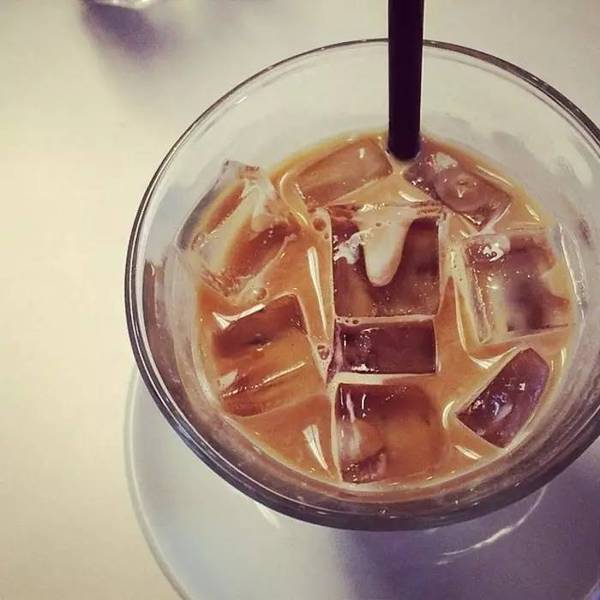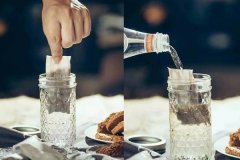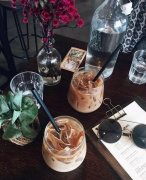How to deal with the processing of single beans in Fuyin Manor? how to divide the grades of single beans in Fuyin Manor?

Professional barista communication, please pay attention to coffee workshop (Weixin Official Accounts cafe_style)
Indonesia Fu Yin Manor
Sumatra, Indonesia's second largest island, is the center of Indonesia's oil industry. Rubber and timber on the island are also famous export commodities. Sumatra coffee, however, is more striking, similar to Java coffee, but slightly heavier in size. Mandheling and Ankola coffee beans are also highly valued, with Mandheling even being hailed as the world's most granular coffee beans
Java coffee beans early years of Java coffee fame, here refers to the former Java produced Arabica coffee. It has a rich aroma, low acidity, smooth taste, and with mocha coffee, the result is "Java mocha mixed coffee" once popular, synonymous with top coffee, fame spread.
Java coffee sold to Europe at that time was a very special coffee. Because it was shipped to European and American countries by sailboat at that time, the journey was long and the speed was slow, so it took a lot of time on the way. Coffee in this case, as if after a special fermentation, taste very unique.
Later, when ships replaced sailboats, people drank fresher coffee beans because of shorter delivery times. But people accustomed to old beans are not used to this fresh taste, so they desperately pursue old Java coffee, so that the Indonesian government and some businessmen deliberately store fresh beans in warehouses for one to two years before selling them to consumers. In fact, the acidity of aged Java beans is reduced to nearly zero compared to fresh beans, while the aroma is more intense. Because of the long storage time, the cost increases a lot, and the quantity is limited, so aged Java has always been a hot commodity in the coffee market. In the 1880s, some traders deliberately tampered with fresh Guatemala or Venezuela beans to copy old Java and sell them at high prices. What is intolerable is that 0 traders dye coffee beans in a way that makes them look more like aged java, but there is no doubt that the dyeing chemicals are poisonous.
Among the coffee-producing Asian countries, Indonesia is one of the most noteworthy. Indonesia is an island country in the Indian Ocean, with islands on either side of the equator, three of which: Java, Sumatra and Surawesi produce globally important coffee. In the mid-17th century, the Dutch brought coffee trees to Ceylon (Sri Lanka) and Java in Indonesia. By the 18th century, Indonesia had become a major producer of coffee, supplying almost all of its high-quality Arabica coffee to Europe. But in the 19th century, coffee rust, which appeared in Ceylon as early as 1869, also affected Indonesia. By 1877, most of the coffee fields on the Indonesian islands had been destroyed by rust, and the Dutch had to import another coffee variety from Africa, namely Romstar coffee. It is more resistant to pests and diseases, but the quality is inferior. About 90% of Indonesian coffee is Romstar beans, about 6.8 million bags a year, less than 10% of the beans are Arabica coffee Java Island, the oldest producing area, Java coffee's reputation continues from the 18th century Indonesian coffee glory era, mention Java coffee, still can be associated with high quality delicious, then the most famous blend is to Java coffee with Yemen mocha. In addition, Java has a famous aged coffee, or monsoon coffee.
Java produces only a small number of arabica beans, most of which are Romstar beans imported from Africa after the rust disaster. The roasted coffee has a strong bitter taste but an extremely light aroma. Although it has a low acidity and a delicate taste, it is rarely used as a direct drink. It is often used to blend coffee or to make instant coffee. Java coffee is produced in Java, Indonesia. It belongs to Arabica coffee. After baking, the bitter taste is very strong and the fragrance is very light, without sourness. Java coffee bitter, alcohol, coupled with the sweet chocolate syrup, Java coffee more mellow smooth, very popular with women!
Sumatra Island, the most legendary producing area, famous coffee labels include Mandheling, Lintong, Gayo Mountain.
In Sulawesi, famous coffees include Traga Toraja.
In addition, Bali, Flores, Timor are also important production areas.
Coffee growing methods
During the Dutch colonial era, coffee cultivation was dominated by large manors. After World War II, after the nationalization process and independence movement, about 90% of Indonesia's coffee production is now produced by small farmers.
coffee varieties
Overall, Indonesian coffee is strong, mellow, slightly syrupy, and has excellent acidity, reflecting its excellent quality in that its two main export markets are Germany and Japan. What appeals to consumers is the exceptional quality of its arabic coffee beans. You can add milk or cream to high-quality Indonesian coffee without worrying about affecting its taste. Indonesian coffee is divided into six grades, the best is AP. But no one knows exactly what these two capital letters represent.
Indonesia Indonesia
Population: 23,742,400
In Indonesia, coffee beans slowly spread from Java to neighboring islands, reaching Sulawesi first in 1750, before extending to northern Indonesia. After planting began around Lake Toba in 1888, it eventually spread to Lake Tawar in the Gayo region in 1924.
SUMATRA
Sumatra has three main cultivation areas: the northern part of Aceh, the area slightly south around Lake Toba, and the recently emerged islands near Mangkuraja. It may also be traced to smaller areas of Takengon, Bener Mariah in Aceh, Lintong, Sidikalang, Dolok Sanggul and Seribu Dolok around Lake Doba. Coffee beans sold in the area were commonly known as "Sumatra Mantenin," but there is no actual place name for Mantenin, which comes from the ethnic name of the local islanders. Usually there are grades of mantenin, classified as Grade1 or Grade2. The grading method is undoubtedly based on cup testing quality rather than the generally believed raw beans themselves. But I'm still skeptical about recommending Grade1, because it seems to be flooding. It's odd to divide the varieties into batches, so most Sumatra beans are a mix of unknown varieties. Sumatra coffee beans are exported through Medan port, but they stay at the port for too long before export, and the hot and humid climate factors will not be conducive to the quality of coffee beans.
Altitude: Aceh 1100-1300m, Doba Lake 1100-1600m, Mangkuraja1100-1300m
Harvest: September-December
Varieties: Typica (including Bergandal, Sidikalang, Djember), Timtim, Ateng, Onan Gajang
JAVA
In Indonesia, this area inherited Dutch colonial customs and customs, so there are more large coffee plantations. The four main coffee fields, covering 4000 hectares, were formerly government estates. Coffee beans from this region enjoyed a reputation for excellence at the time, although I believe that a large number of formula beans have replaced "Mocha-Java" coffee beans not long ago. Java coffee beans used to be high for a long time, but in the 20th century there has been a significant decline in prices. The planting area covers the vicinity of Ijan volcano in eastern Java and western Java.
Altitude: 900-1800m
Harvest: September-September
Varieties: Typicas, Ateng, USDA
SULAWESI
Even though seven plantations supply about 5 per cent of Sulawesi's production, local production is dominated by smallholder supply. Most Arabica beans are grown high around Tana Toraja, Kalosi in the south is a brand, and two lesser-known areas are west of Mamasa and south of Kalosi, Gowa. There are a few particularly interesting coffee beans that have been washed, which are worth pondering and are highly recommended to try when you have the opportunity. Semi-washing treatment is a common method in Sulawesi, and local production is also quite a lot of Roast beans.
Tana Toraja 1100-1800m, Mamasa 1300-1700m, Gowa average 850m
Harvest: May-November
Breed: S795, Typicas, Ateng
FLORES
Flores is a small island located about 320 km (200 mi) east of Bali, one of the Indonesian archipelagos. As a latecomer to the coffee industry, it has developed a good reputation for growing coffee. In the past, Flores produced coffee that was mostly sold domestically or mixed with other coffees for export, and rarely sold directly under the name "Flores Coffee." There are active and dormant volcanoes on the island, with a mixture of Bajawa volcanoes having a great positive impact on the main cultivation areas. In coffee processing, the semi-wash process is the most common treatment in the region, and some coffee beans are still produced by the full wash process.
Tana Toraja 1200-1800m, Mamasa 1300-1700m, Gowa average 850m
Harvest: May-September
Varieties: Typicas, Ateng, Robusta
BALI
Coffee came to Bali relatively late and was originally grown on the Kintamani plateau. Coffee production was greatly affected by the Gunung Agung eruption in 1963, which killed more than 20,000 people and caused extensive damage to eastern Bali. In the late 1970s and early 1980s, the government distributed Arabica seedlings to boost coffee production, but this was considered to be of limited effect because today about 80 percent of the island's production consists of robusta beans. Although tourism provides the largest revenue, agriculture employs the largest number of people on the island, and Japan used to be the largest buyer.
Altitude: 1,250- 1,700 m
Harvest: May-October
Varieties: Typicas, Typica derivatives, Robusta
Initially, Indonesian coffee was Arabica, but leaf rust destroyed Arabica plantations in the late 18th century. Initially, the Dutch tried to grow Liberian coffee, and later, large-scale cultivation of Robusta coffee began.
Arabica now accounts for about 10-15% of Indonesia's coffee production, with Robusta making the rest. Liberica is produced but largely excluded from the coffee trade
Sumatra, Indonesia's second largest island, is the center of Indonesia's oil industry. Rubber and timber on the island are also famous export commodities. Sumatra coffee, however, is more striking, similar to Java coffee, but slightly heavier in size. Mandheling and Ankola coffee beans are also highly valued, with Mandheling even being hailed as the world's most granular coffee beans.
Sulawesi, located between Borneo and New Guinea, is sometimes called Celebes. The coffee produced on the island is full of particles and rich in flavor. The best coffee beans are grown in Kalossi and Rantepao in the south of the island. Among the many tastes, try Celebes Carlochy Coffee.
When ships replaced sailboats, coffee from these islands faced the same problem as Indian coffee from Mysore-consumers were used to coffee affected by long journeys and therefore did not want to accept the taste of "fresh" coffee. To solve this problem, the Indonesian government has tried to imitate coffee affected by long trips, and they have "stored" coffee beans for up to a year. However, the taste of this moist coffee is not widely accepted, so that it affects the good reputation of coffee.
However, Indonesian "storage" coffee or "journey" coffee is still produced today. It is sold under the brand names Old Government, Old Brown and Ool Java.
Although Indonesia produces so much good coffee, it is puzzling that the local population prefers Turkish-style coffee to its famous European-style coffee, which was introduced to Indonesia by the Dutch in the mid-17th century (some official sources say earlier). 1712 The first coffee from Java arrives in Amsterdam. However, in 1877 coffee trees on all plantations were destroyed by coffee rust, and robert coffee trees had to be imported from Africa to replace the original species. Today only 6 -10% of coffee beans are Arabica beans. Indonesia is the world's leading producer of Roscoff coffee, producing 6.8 million bags of coffee annually, most of which comes from small plantations, accounting for about 90% of total production.
Java produces fine aromatic coffee with relatively low acidity, fine taste and good balance. Java coffee has a superior aroma and acidity to Sumatra and Sulawesi coffees. The best plantations in Java are Blawan, Jambit, Kayumas and Pankur. Java mocha coffee is a blend of Java coffee and Yemeni mocha coffee.
Important Notice :
前街咖啡 FrontStreet Coffee has moved to new addredd:
FrontStreet Coffee Address: 315,Donghua East Road,GuangZhou
Tel:020 38364473
- Prev

How is the planting of single bean in Fuyin Manor? introduction to the award of single bean in Fuyin Manor
Professional baristas please follow the coffee workshop (Wechat official account cafe_style) Indonesia Fuyin Manor in the Asian countries that produce coffee, Indonesia is a very noteworthy one. Indonesia is an island country in the Indian Ocean, the islands are distributed on both sides of the equatorial line, of which three islands: Java, Sumatra and Sulawesi produce the world's important coffee. The 17th century
- Next

Is the single bean of Ladisha Manor delicious? the planting and processing of single bean of Ladisha Manor
For the exchange of professional baristas, please follow the coffee workshop (Wechat official account cafe_style) La Tisa Manor Guatimala Guatemala population: 15438000 Guatemala has been more successful in defining its coffee priority areas than most countries and has developed the market with a very different sales model.
Related
- Does Rose Summer choose Blue, Green or Red? Detailed explanation of Rose Summer Coffee plots and Classification in Panamanian Jade Manor
- What is the difference between the origin, producing area, processing plant, cooperative and manor of coffee beans?
- How fine does the espresso powder fit? how to grind the espresso?
- Sca coffee roasting degree color card coffee roasting degree 8 roasting color values what do you mean?
- The practice of lattes: how to make lattes at home
- Introduction to Indonesian Fine Coffee beans-- Java Coffee producing area of Indonesian Arabica Coffee
- How much will the flavor of light and medium roasted rose summer be expressed? What baking level is rose summer suitable for?
- Introduction to the characteristics of washing, sun-drying or wet-planing coffee commonly used in Mantenin, Indonesia
- Price characteristics of Arabica Coffee Bean Starbucks introduction to Manning Coffee Bean Taste producing area Variety Manor
- What is the authentic Yega flavor? What are the flavor characteristics of the really excellent Yejasuffi coffee beans?

